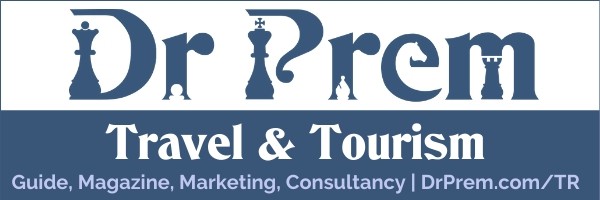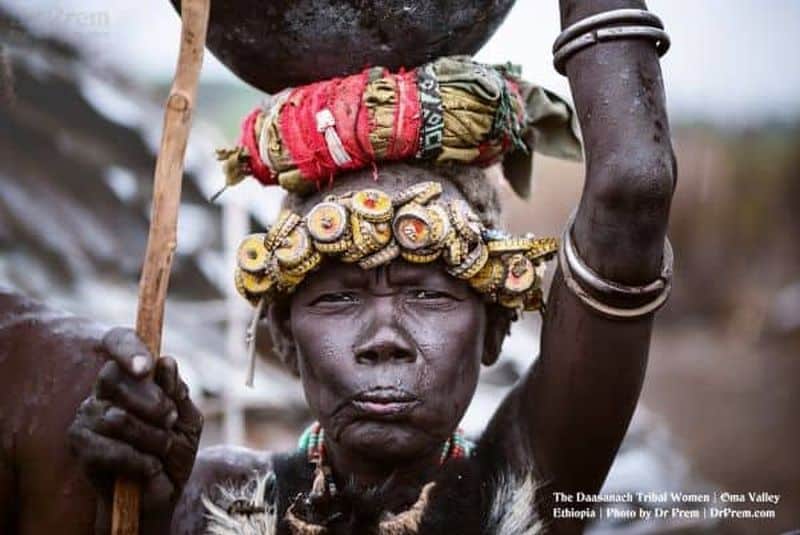During my recent trip to Ethiopia, I had the opportunity to explore the rich tribal culture of the Land of Origins. Among several tribes inhabiting this nation, the Dassanach tribe deserves a special mention for being a lively, brave, colorful, and highly courteous tribe. An Ethiopian ethnic community, the Dassanach tribe is demographically distributed in parts of Ethiopia extending across the border to Kenya and Sudan. However, primarily they are concentrated in the Debub Omo zone of the Southern Nations and Nationalities and Peoples region. Here are some of my findings that I would love to share with you all.
Appearance
Dassanach are dark skinned folks with muscular physique and typical Negroid features. They have almond shaped faces with high cheekbones and thick lips; however, their nasal construction is quite striking. While women wear necklaces with multicolored beads, it’s a fashion among many Dassanach girls to wear impressive head dresses and wigs made up of cute little accessories.
I agree to the fact that Dassanach are the masters of body decor. They love to put on earrings, necklaces, bracelets and anklets fitted with colorful beads. Men would wear a typical head gear if they have recently slaughtered a harmful and menacing beast or an enemy. Their head gear is pronounced and often decked with tufts of ostrich feathers. Scarification is rampant that marks a win over a foe. For me, it was a thrilling experience to meet one of the most colorful tribal folks walking this planet. I, being a shutterbug addict, didn’t let go any opportunity to frame their wonderful body art.
Beliefs
The Dassanach tribesmen actually cross the boundary of typical ethnicity. They are divided into several clans. Practice of circumcision is in vogue. A man or a woman can be included as a part of a Dassanach clan so long as he or she gives consent to getting circumcised. Each of the clans can be identified by their own sets of customs, philosophies and rituals and their duties towards the rest of the tribes, and they are identified with a particular territory.
Conquering crocs
The largest of the clan known as the Galbur are also termed as the water or the crocodile clan. They firmly hold a conviction that the members of this clan have a grip over water and its resident – the crocodile. The Galbur tribe absorbed me completely by their imposing presence. Whether they are able to rein a croc underwater is a different matter, but their physical presence was so overwhelming. I found it practically impossible to have an eye to eye contact with a Galbur for more than a few seconds.
The Turat clan takes pride in their magical potential to deal with and cure fire burns. They also have the powers to drive away snakes and cattle raiders. They have a profound faith in their disease curing powers. The Turnyerim clan has the power to control draught and pray for rains during dry spells. They believe that they have the potential to cure snake bites by spitting on the wound. Some other clan members also believe that they have healing powers over eye infection, scorpion stings and muscle pain.
Taboos
Members of the same clan are not allowed to marry each other. It is a taboo to even participate in a dance with the members of the same clan.
History
Modern research on the genetic makeup of the Dassanach tribe reveals that they are more closely connected genetically to the Nilo – Saharan and Niger – Congo speaking tribes living in Tanzania than the Cushitic and Semitic Afro Asiatic population inhabiting Ethiopia. This leads to the fact that the Dassanachs were originally Nilo Saharan speakers, sharing a common origin with the Pokot tribe living in the west Pokot country and Baringo country in Kenya.
Way back in the 19th century, the ancestors of these two African stocks have been believed to have migrated separately going their own ways. One group moved southwards towards the African Great Lakes and the other group settled in Southern Ethiopia of which the modern-day Dassanach are descendants. Casting a sidelong glance at the rugged landscape and the distant highlands standing stark against the azure sky, I wandered such migrations themselves must have been a grand human feat.
Population
According to the census carried out in 2007, there are around 48,000 Dassanach people out of which around 1,500 are urban dwellers. They speak the Dassanach language which belongs to the Cushitic branch of the Afro Asiatic family.
Lifestyle
Check Dr Prem’s Tribal Tourism Photo Gallery
Dassanachs are traditionally pastoralists herding cattle, goat and sheep. But in recent times, their occupation profile has changed to a mix of farming and cattle grazing. Having lost their cattle grazing acres over past fifty years because of being expelled from the traditional Kenyan lands, they have suffered a massive loss in their inventory of cattle wealth. Consequently, a majority of Dassanach population has moved closer to the Omo River where they can grow sufficient crops on receding flood water fertilized soil and sustain their existence.
Akin to most of the pastoral tribes dwelling in the north eastern and eastern parts of the continent of Africa, the Dassanach are a highly fair society where equitable justice is delivered with a social system involving age sets and clan ancestry. They are basically agro pastoral people cultivating shorgum, maize corns, pumpkins and beans on the flooded plains of the Omo River.
Cattle grazers live in dome shaped houses made out of boughs and twigs framed together. The roof top is covered with hides and wooden boxes. Huts are provided with hearth and mats are spread on the floor where they sleep.
Another clan known as the Dies who lost their entire cattle wealth and the means to survive constitutes the lowest economy bracket among the Dassanach. They have settled down along the shores of Turkana Lake and are forced to choose a career in crocodile hunting and fishing. Nevertheless, they continue their barter trade with the mainstream herdsmen swapping crocodile meat and the fresh catch of fishes with cattle meat.
Dassanachs are also known for raising donkeys and camels. The tribes trade with each other for beads, meat, hides and apparel. Of late, they have started trading in arms and ammunition as well and other merchandise of regular use.
Administrative system
The Dassanachs are regulated administratively by a system, which is one of the oldest political systems in Africa. It divides people into age categories with the objective of establishing social, political and economic structure. A group of 30 elderly and wise men called the bulls (Ara) enjoys administrative powers.
Though it is a society where the male voice rules, the birth of a baby girl is rejoiced and celebrated as well. Among Dassanachs, the most important celebration in a man’s life is called Dimi when he finds an occasion to bless his daughter’s fertility attainment and she is declared fit for marriage. Around 10 to 30 cattle are slaughtered to mark this ceremony.
Favorite food
The Dassanach consume shorgum, maize corns, pumpkins and beans. They are also greatly fond of cattle meat and milk. Shorgum is mixed with water and cooked to prepare a kind of local porridge. It is eaten with a local stew. Corn is consumed roasted. Shorgum however finds another use as it is fermented and brewed into beer.
Habits
Circumcision is a habitual practice in both the sexes. Women are circumcised by removing the clitoris. Women who don’t pass this ritual or don’t offer themselves altogether to this ritual are considered animals and cannot be married ever or wear clothes for that matter. They are even jeered by men for not having circumcised. Men wear chequered cloth around their waist. Women wear a pleated cow skin skirt and bracelets. They are usually considered fit for marriage when they attain 18 years. For men, it is 20 years.
Challenges
Disease and its devastating effects upon the tribe is a major challenge. There is an abundance of diseases along the river banks including Tsetse fly assaults. Plantation of woodlands has mitigated the economic crisis of this tribe but has also given shelter to the deadly tsetse flies.
Yet the major challenges faced by the Dassanach tribe are the scarcity of water and rising temperature of the region.
What the climatic temperature had been 20 years ago is not the same as of now. The temperature has increased dramatically causing large scale evaporation of water from Lake Turkana on which the tribe depends so much. The water scarcity has practically given rise to water conflict between tribes depending upon Lake Turkana. The conflict has led to rampant use of Kalashnikovs’ by the Dassanach and counter retaliation by rival tribes competing for the scarce water resources in the region which is a big challenge.
To add to the rising plight of the tribe, construction of the Dam Gibe III had been a dehumanizing project. Here the Dam across river Omo diverted the flood waters on which the Dassanach depend so much for agricultural use. This project had been a big economic blow to the tribe, which eventually deprived them of the floodwater-enriched fertile silt that had been supportive of prolific growth of food and cash crops. Those voiced their protests were silenced brutally.
Forcible acquisition of land by the Land Grab policy has snatched away their daily bread.
Leasing out of blocks of fertile land to foreign companies for encouraging plantation of biofuel generating vegetation had been the final nail driven through the Dassanach coffin.
Parting with these people was not easy as their warm generosity made me feel at home. However, the time was short and I needed to move ahead for more such fascinating experiences.
Read More :
The Hamar Tribe: Beyond paganism, rivalries, appearances, taboos and all…
Mursi are the most fascinating and valiant Ethiopian tribes – Dr
Ethiopia’s Karo tribe is a decent mix of amity, color and vigor


